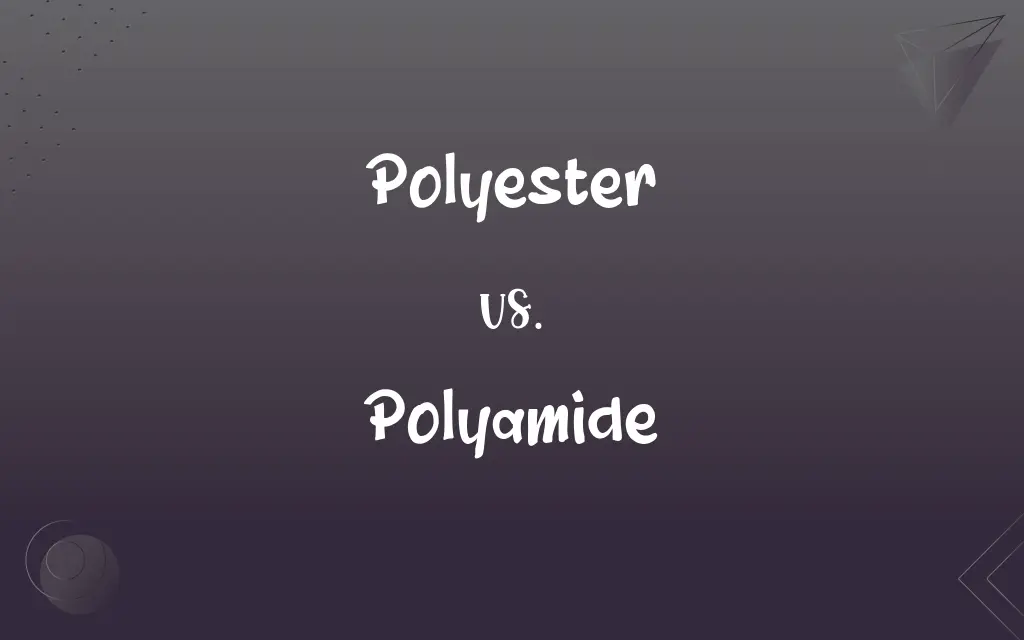Polyester vs. Polyamide: What's the Difference?
Edited by Aimie Carlson || By Janet White || Published on December 25, 2023
Polyester is a synthetic fiber known for its durability and resistance to wrinkling, while polyamide (nylon) is known for its strength and elasticity.

Key Differences
Polyester, a synthetic fabric, is prized for its durability, resistance to shrinking and wrinkling, and its ability to hold color well. Polyamide, also synthetic, is recognized for its high strength, elasticity, and excellent abrasion resistance.
In terms of moisture absorption, polyester tends to be hydrophobic, meaning it does not absorb much water and dries quickly. Polyamide, on the other hand, has a higher moisture absorbency rate, making it more comfortable to wear in hot and humid conditions.
Polyester is often used in a variety of applications, from clothing and home furnishings to industrial materials, due to its versatile nature. Polyamide is commonly used in sportswear, swimwear, and outdoor gear, where its strength and resilience to wear are beneficial.
The texture of polyester can vary but is generally smoother and can sometimes feel synthetic, whereas polyamide fabrics are typically softer and have a more natural fabric feel.
In terms of environmental impact, both polyester and polyamide are not biodegradable, but recycling efforts and sustainable practices are increasing for both materials.
ADVERTISEMENT
Comparison Chart
Durability
Highly durable, resistant to shrinking and wrinkling
High strength, excellent abrasion resistance
Moisture Absorption
Low moisture absorption, dries quickly
Higher moisture absorption, comfortable in humidity
Common Uses
Clothing, home furnishings, industrial materials
Sportswear, swimwear, outdoor gear
Texture
Can feel smoother and more synthetic
Softer, more natural fabric feel
Environmental Impact
Not biodegradable, recycling efforts increasing
Not biodegradable, with growing sustainable practices
ADVERTISEMENT
Polyester and Polyamide Definitions
Polyester
Polyester is a synthetic fabric known for its durability and resistance to wrinkling.
Her new dress was made of polyester, which meant it hardly ever needed ironing.
Polyamide
It is often used in activewear for its moisture-absorbing and quick-drying properties.
His polyamide running shorts were comfortable and dried quickly after a rainy jog.
Polyester
It's widely used in textiles due to its ability to retain color and resist shrinkage.
The polyester curtains held their vibrant color even after years of sunlight exposure.
Polyamide
Polyamide, commonly known as nylon, is a synthetic fabric known for its strength and elasticity.
Her polyamide stockings were remarkably durable and stretchy.
Polyester
It is commonly used in outdoor and performance wear for its quick-drying quality.
His polyester jacket was perfect for hiking as it dried quickly in damp conditions.
Polyamide
Polyamide is appreciated for its softness and more natural fabric feel compared to other synthetics.
The polyamide blend shirt felt soft and natural, unlike typical synthetic materials.
Polyester
Polyester fabrics can vary in texture, often feeling smooth and slightly synthetic.
The polyester tablecloth had a smooth, almost silky texture.
Polyamide
Polyamide is also used in industrial applications for its high abrasion resistance.
The polyamide ropes were chosen for their strength and resistance to wear.
Polyester
Polyester is often blended with other fibers to enhance fabric properties.
The sweater was a mix of polyester and cotton, combining durability with comfort.
Polyamide
It's a popular choice for swimwear and outdoor gear due to its durability in wet conditions.
The polyamide swimsuit retained its shape and color despite frequent use in chlorinated pools.
Polyester
Any of numerous synthetic polymers produced chiefly by reaction of dicarboxylic acids with dihydric alcohols and used primarily as light, strong, weather-resistant resins in boat hulls, textile fibers, adhesives, and molded parts.
Polyamide
A polymer containing repeated amide groups, as in various kinds of nylon.
Polyester
A wrinkle-resistant fabric of fibers made from any of these resins.
Polyamide
(chemistry) Any of a range of polymers containing amide (or peptide) repeat units; examples include proteins and nylon.
Polyester
Any polymer whose monomers are linked together by ester bonds
Polyamide
A polymer containing repeated amide groups
Polyester
A material or fabric made from polyester polymer
Polyester
Of, or consisting of polyesters
Polyester
Any of numerous synthetic resins; they are light and strong and weather resistant
Polyester
A complex ester used for making fibers or resins or plastics or as a plasticizer
Polyester
Any of a large class of synthetic fabrics
FAQs
What are polyamide's key characteristics?
High strength, elasticity, and comfort in humid conditions.
What is polyester primarily known for?
Its durability, resistance to wrinkling, and color retention.
What are common uses of polyester?
Clothing, home furnishings, and various industrial materials.
Does polyamide absorb moisture?
Yes, it has higher moisture absorption compared to polyester.
How does polyamide feel compared to other synthetics?
It's softer and has a more natural fabric feel.
Where is polyamide typically used?
In sportswear, swimwear, and outdoor gear.
Can polyester blend with other fibers?
Yes, it's often blended to enhance fabric properties.
How does polyester perform in outdoor conditions?
Very well, due to its quick-drying and durable nature.
Is polyester water-resistant?
Yes, it tends to repel water and dries quickly.
Can polyester feel synthetic?
Yes, it can have a smoother, more synthetic texture.
Is polyester used in performance wear?
Yes, particularly for its quick-drying and durable qualities.
Are polyester fabrics biodegradable?
No, but recycling and sustainable practices are increasing.
Is polyamide environmentally friendly?
Like polyester, it's not biodegradable, but sustainable options are growing.
What industrial uses does polyamide have?
Its strength makes it suitable for ropes and other high-stress applications.
How should polyamide fabrics be cared for?
They should be washed gently and avoid high heat to maintain elasticity and shape.
What makes polyamide suitable for activewear?
Its moisture absorption, quick drying, and elasticity.
Why is polyamide used in swimwear?
For its durability, especially in wet and chlorinated conditions.
How does polyamide compare to polyester in strength?
Polyamide is generally stronger and more abrasion-resistant.
Does polyester require special care?
It's low-maintenance but should be washed at lower temperatures to preserve its qualities.
Can polyester be recycled?
Yes, there are increasing efforts to recycle polyester.
About Author
Written by
Janet WhiteJanet White has been an esteemed writer and blogger for Difference Wiki. Holding a Master's degree in Science and Medical Journalism from the prestigious Boston University, she has consistently demonstrated her expertise and passion for her field. When she's not immersed in her work, Janet relishes her time exercising, delving into a good book, and cherishing moments with friends and family.
Edited by
Aimie CarlsonAimie Carlson, holding a master's degree in English literature, is a fervent English language enthusiast. She lends her writing talents to Difference Wiki, a prominent website that specializes in comparisons, offering readers insightful analyses that both captivate and inform.







































































